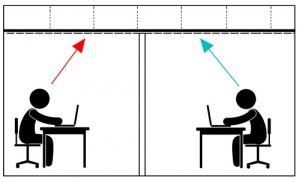Suspended ceiling treatments are essential to office acoustics. We will cover how they relate to several office related noise problems and how suspended ceiling treatments can help. While this article is geared towards office applications, please note that many of these principles can also be applied to school classrooms, commercial spaces, and residential applications.
Drop tile ceilings are one of the most common sights you will see in a typical office setting. Drop ceilings are essentially a secondary ceiling that is installed beneath the main, structural ceiling. They are also sometimes referred to as suspended ceilings, T-bar ceilings, false ceilings, and grid ceilings. Usually, they are installed in to hide the framework make-up of the building structure including wiring, piping, and duct work. They also commonly house fire sprinklers and fire suppression systems. This allows for the tiles to be easily replaced in case of fire or other building damage.
There are many decorative tiles available on the market these days. Most offices seem to use the same plain white industrial ceiling tiles that are readily available from building supply stores. The problem is that they are very thin. Although they are sometimes referred to as “acoustic ceiling tiles”, they are in reality very far from it. Basically, they just allow for sound to pass through them uninhibited. This can cause a number of different problems which I will outline below, along with resolutions to treat them effectively.
Sound Transmission Between Rooms
In many office environments, the shared walls between offices and conference rooms do not extend all the way to the structural ceiling deck, but rather ends where the drop ceiling grid begins. This can allow for sound to flank between the two spaces so that the person(s) in each office hears the other loud and clear whenever they are talking, typing, etc. (Ex. 1). This can be a big nuisance to the workers in each space, especially if your neighbor tends to be a loud talker!
Thankfully, there are a couple of ways that you can fix this. In order to block the sound from going up above the tiles and over into the adjoining room, you have to install a barrier material in the drop ceiling. This is an actual, productive suspended ceiling treatment. You can insert a Drop Tile Ceiling Barrier above the existing tiles or by replacie the existing tiles with a tile that has a barrier material already on it (Ex. 2). Our Signature Barrier Ceiling Tiles are a good example of this.
Both of these materials contain a layer of Mass Loaded Vinyl Barrier (a heavy, dense material used to block sound) to help stop noise from traveling up and over into the room next door. For this treatment to work effectively, completely cover the entire ceiling of at least one of rooms. Partial treatment will still allow for sound to move through the untreated area.
Office And Conference Room Echo
Offices and conference rooms with lots of hard surfaces and high ceilings often have echo and speech intelligibility problems. As is the case with sound flanking between rooms, standard ceiling tiles do not usually have very good absorptive qualities either. Suspending ceiling treatments are the answer here.
As mentioned previously, sound tends to pass through them which allows for it to hit the ceiling deck and bounce back down. This can wreak havoc in rooms where speech intelligibility is of high importance (Ex. 3). No one wants to be on a conference call where they cannot decipher what the person on the other line is saying and vice versa. While we almost always recommend absorptive wall panels in this type of situation, sometimes the make-up of the room does not allow for that type of treatment (lack of wall space, walls made from glass, etc.). Installing specialty absorptive ceiling tiles designed for acoustics can be a big help in this situation. These tiles use thicker materials (usually compressed fiberglass or melamine foam). This is to help dampen and reduce the amount of noise that can bounce around the room.
Absorptive ceiling tiles come in many different styles and can have various facings to match the room’s decor. Examples of these suspended ceiling treatments include fabric-faced tiles, patterned foam tiles, metal-faced tiles, and wood wool. Certain tiles can even offer thermal benefits in addition to acoustic and these tiles also work well in open office areas, call centers, etc.
To learn more about how Acoustical Solutions can solve your noise control problems, use our contact form, call one of our Acoustical Sales Consultants at (800) 782-5742, or visit us on the web at acousticalsolutions.com.




Hello, I am looking for a product to eliminate noise from the Director of Human Resources office to the surrounding offices. We have a t-grid drop ceiling and I am looking at your sound barrier tiles to replace the existing tiles. And was wondering what your success rate was with these tiles?
Hello Brian,
Thank you visiting!
You can achieve a significant perceivable difference in sound attenuation using the sound barrier tiles as long as you treat the entire ceiling of the room you are trying to block sound from. If you only partially replace tiles, you still will allow for sound to carry over into the neighboring rooms. Another material you may also want to look at is our Privacy Shield Drop Tile Ceiling Barrier. This material can sit above your existing ceiling tiles and provides the same sound blocking characteristics as the barrier ceiling tiles you were looking at.
Hi,
I Desperately need a recommendation to reduce the noise in our two commercial kitchens? Each have a walkin refrigerator and freezer which make an awful lot of noise due to their motors sitting on top – all indoors, and running in a small enclosed space. Not a lot of height between the ceiling and top of walkins. They need ventilation so I’m afraid to put a sound proof box over top. (Also trying to keep the input of noise absorption for out put of heat to be feasible for our walkins) We have ceiling drop tiles and frp stucco walls:( Please help.
Hi Farah, thank you for contacting Acoustical Solutions. My initial thought is to use acoustical foam panels behind and to the sides of the motors as well as possibly on the ceiling, however I would be able to make a more in depth recommendation if you could provide me with a few pictures of the space so that I can determine what the best course of action would be. If you could, please reply back to me directly with some pictures and we can go from there. Please let me know if you have any other questions or would like to discuss this further.